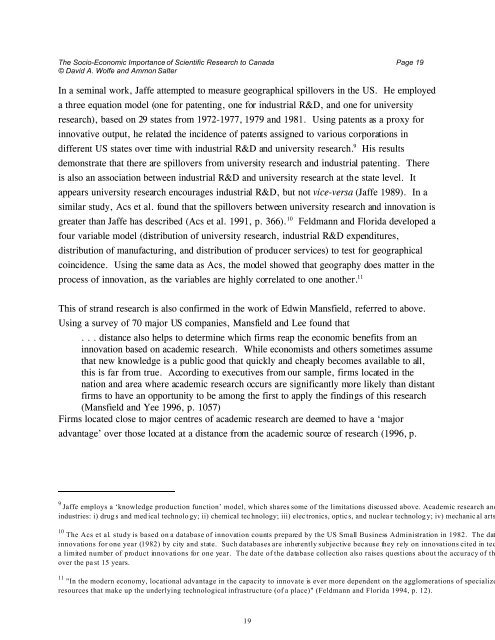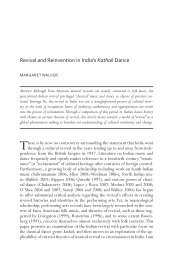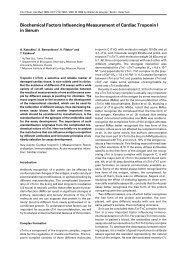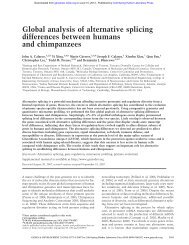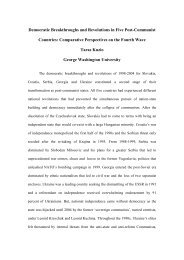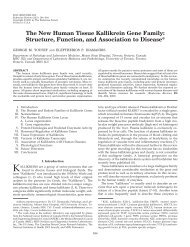The Socio-Economic Importance of Scientific Research To Canada
The Socio-Economic Importance of Scientific Research To Canada
The Socio-Economic Importance of Scientific Research To Canada
You also want an ePaper? Increase the reach of your titles
YUMPU automatically turns print PDFs into web optimized ePapers that Google loves.
<strong>The</strong> <strong>Socio</strong>-<strong>Economic</strong> <strong>Importance</strong> <strong>of</strong> <strong>Scientific</strong> <strong>Research</strong> to <strong>Canada</strong> Page 19© David A. Wolfe and Ammon SalterIn a seminal work, Jaffe attempted to measure geographical spillovers in the US. He employeda three equation model (one for patenting, one for industrial R&D, and one for universityresearch), based on 29 states from 1972-1977, 1979 and 1981. Using patents as a proxy forinnovative output, he related the incidence <strong>of</strong> patents assigned to various corporations indifferent US states over time with industrial R&D and university research. 9 His resultsdemonstrate that there are spillovers from university research and industrial patenting. <strong>The</strong>reis also an association between industrial R&D and university research at the state level. Itappears university research encourages industrial R&D, but not vice-versa (Jaffe 1989). In asimilar study, Acs et al. found that the spillovers between university research and innovation isgreater than Jaffe has described (Acs et al. 1991, p. 366). 10 Feldmann and Florida developed afour variable model (distribution <strong>of</strong> university research, industrial R&D expenditures,distribution <strong>of</strong> manufacturing, and distribution <strong>of</strong> producer services) to test for geographicalcoincidence. Using the same data as Acs, the model showed that geography does matter in theprocess <strong>of</strong> innovation, as the variables are highly correlated to one another. 11This <strong>of</strong> strand research is also confirmed in the work <strong>of</strong> Edwin Mansfield, referred to above.Using a survey <strong>of</strong> 70 major US companies, Mansfield and Lee found that. . . distance also helps to determine which firms reap the economic benefits from aninnovation based on academic research. While economists and others sometimes assumethat new knowledge is a public good that quickly and cheaply becomes available to all,this is far from true. According to executives from our sample, firms located in thenation and area where academic research occurs are significantly more likely than distantfirms to have an opportunity to be among the first to apply the findings <strong>of</strong> this research(Mansfield and Yee 1996, p. 1057)Firms located close to major centres <strong>of</strong> academic research are deemed to have a ‘majoradvantage’ over those located at a distance from the academic source <strong>of</strong> research (1996, p.9 Jaffe employs a ‘knowledge production function’ model, which shares some <strong>of</strong> the limitations discussed above. Academic research andindustries: i) drugs and medical technology; ii) chemical technology; iii) electronics, optics, and nuclear technology; iv) mechanical arts10 <strong>The</strong> Acs et al. study is based on a database <strong>of</strong> innovation counts prepared by the US Small Business Administration in 1982. <strong>The</strong> datinnovations for one year (1982) by city and state. Such databases are inherently subjective because they rely on innovations cited in teca limited number <strong>of</strong> product innovations for one year. <strong>The</strong> date <strong>of</strong> the database collection also raises questions about the accuracy <strong>of</strong> thover the past 15 years.11 "In the modern economy, locational advantage in the capacity to innovate is ever more dependent on the agglomerations <strong>of</strong> specializeresources that make up the underlying technological infrastructure (<strong>of</strong> a place)" (Feldmann and Florida 1994, p. 12).19


